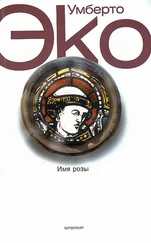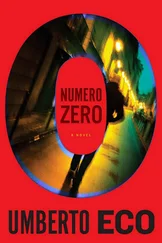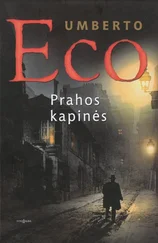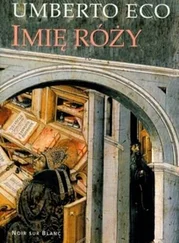Umberto Eco - The Mysterious Flame Of Queen Loana
Здесь есть возможность читать онлайн «Umberto Eco - The Mysterious Flame Of Queen Loana» весь текст электронной книги совершенно бесплатно (целиком полную версию без сокращений). В некоторых случаях можно слушать аудио, скачать через торрент в формате fb2 и присутствует краткое содержание. Жанр: Исторический детектив, на французском языке. Описание произведения, (предисловие) а так же отзывы посетителей доступны на портале библиотеки ЛибКат.
- Название:The Mysterious Flame Of Queen Loana
- Автор:
- Жанр:
- Год:неизвестен
- ISBN:нет данных
- Рейтинг книги:3 / 5. Голосов: 1
-
Избранное:Добавить в избранное
- Отзывы:
-
Ваша оценка:
- 60
- 1
- 2
- 3
- 4
- 5
The Mysterious Flame Of Queen Loana: краткое содержание, описание и аннотация
Предлагаем к чтению аннотацию, описание, краткое содержание или предисловие (зависит от того, что написал сам автор книги «The Mysterious Flame Of Queen Loana»). Если вы не нашли необходимую информацию о книге — напишите в комментариях, мы постараемся отыскать её.
The Mysterious Flame Of Queen Loana — читать онлайн бесплатно полную книгу (весь текст) целиком
Ниже представлен текст книги, разбитый по страницам. Система сохранения места последней прочитанной страницы, позволяет с удобством читать онлайн бесплатно книгу «The Mysterious Flame Of Queen Loana», без необходимости каждый раз заново искать на чём Вы остановились. Поставьте закладку, и сможете в любой момент перейти на страницу, на которой закончили чтение.
Интервал:
Закладка:
Next to the Corrierino collection was a stack of Il Vittorioso, another weekly, along with some of its large color albums, dating from 1940 on. At around eight years of age then, I must have demanded grown-up literature, with speech balloons.
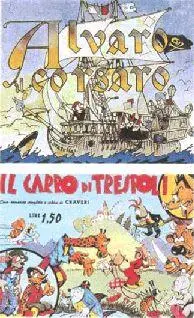
Total schizophrenia there too, with the reader going from delightful episodes in Zoolandia, among characters such as Giraffone the giraffe, Aprilino the fish, and Jojò the monkey, or from the mock-heroic adventures of Pippo, Pertica, and Palla, or of Alonzo Alonzo (Alonzo for short), who was arrested for giraffe theft, to celebrations of Italy’s past glories and to stories directly inspired by the ongoing war.
The ones that affected me most were those about Romano the Le gionnaire, because of the engineer-like precision of the machines of war, the airplanes, the tanks, the torpedo boats and submarines.
Made sharper by having revisited the conflict in the pages of my grandfather’s newspapers, I was now able to match up the dates. For example, the story "Toward I.E.A." began on February 12, 1941. Just a few weeks before, the English had mounted an offensive in Eritrea, and on February 14 they would occupy Mogadishu in Somalia, but despite that Ethiopia still seemed to be solidly in our hands, so it was a good time to move our hero (who till then had been fighting in Libya) to the East African front. Sent on a secret mission to deliver a confidential message to the Duke of Aosta, then commander in chief of the Italian East Africa forces, he traveled from North Africa across the Anglo-Egyptian Sudan. Strange, given that radios existed then and that, as it turned out, the message was in no way confidential (its contents: "Resist and Triumph"); it was as if the Duke of Aosta were simply amusing himself. In any case, Romano traveled with his friends and had various adventures with savage tribes, English tanks, aerial dogfights, and whatever else allowed the artist to make sheet metal shine.
By the time of the March issues, the English had already penetrated deep into Ethiopia, and the only person who seemed unaware of that was Romano, who entertained himself along his route by hunting antelopes. On April 5, Addis Ababa fell, the Italians were regrouping in Galla-Sidamo and Amhara, and the Duke of Aosta was fleeing toward Amba Alagi. Romano continued on straight as an arrow, even taking time to capture an elephant. He and his readers probably thought he was still on his way to Addis Ababa, though by this time the Emperor, deposed exactly five years earlier, had returned. It is also true that in the April 26 issue, a rifle shot shattered Romano’s radio, but that meant that up until then he had one, and so it was unclear why he was not up-to-date on current events.
In mid May, the seven thousand soldiers at Amba Alagi, out of provisions and munitions, surrendered, and the Duke of Aosta was taken prisoner with them. The readers of Il Vittorioso might not have known that, but the poor Duke of Aosta at least should have noticed; instead, Romano meets him on June 7 in Addis Ababa, finding him fresh as a daisy and radiating optimism. Indeed, the Duke reads Romano’s message and affirms: "Of course, and we will resist until victory is achieved."
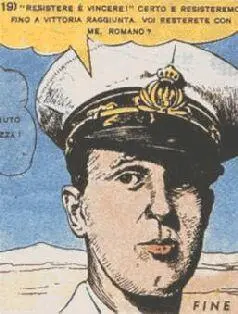
Obviously, these panels had been drawn months earlier, and despite the course of events the editors of Il Vittorioso lacked the courage to cut the series short. They went forward believing that Italy’s children had remained unaware of all the dismal news-and perhaps they had.
The third stack was my collection of Topolino, a weekly dedicated primarily to the exploits of Mickey Mouse (a.k.a. Topolino) and Donald Duck, though it also included stories about brave Balilla Boys, such as "The Submarine Cabin Boy." I was able to trace, through the volumes of Topolino, the transition that began around December of 1941, when Italy and Germany declared war on the United States-I went to double-check my grandfather’s newspapers, and indeed that was how it had happened; I had thought that at a certain point the Americans had tired of Hitler’s pranks and entered the war, but no, it was Hitler and Mussolini who had declared war on the Americans, perhaps thinking they could dispose of them in a matter of months with the help of the Japanese. Since it would clearly have been difficult simply to dispatch a platoon of SS or Blackshirts to occupy New York, we had, for several years already, been waging war in comic books, from which the speech balloons had disappeared, replaced by captions beneath each picture. Then-as I must have seen happen in various comics-the American characters simply began to vanish, replaced by Italian imitations, and in the end- and this, I think, was the last, most painful barrier to fall-the famous mouse was killed. The same adventures continued as if nothing had happened, but from one week to the next, without any notice, the protagonist ceased to be Topolino and became a certain Toffolino, who was a human, not a mouse, although he still had four fingers, like all Disney’s anthropomorphic animals, and his friends, though also humanized, continued to go by their original names. How had I taken it, back then, this crumbling of a world? Perhaps with utter calm, given that the Americans, from one moment to the next, had become bad. But was I even aware, back then, that Topolino was American? My life must have been a roller coaster of dramatic turns, but given all the exciting dramatic turns in the stories I was reading, the dramatic turns in the history I was living must have seemed unexceptional.
After Topolino I found several years’ worth of L’Avventuroso , and that was completely different. The first issue was October 14, 1934.
I could not have bought it myself, since at the time I was not yet three, and I do not think my parents would have bought it for me, as its stories were not at all suitable for children-they were American comics conceived for an audience of adults, if not necessarily grown-ups. So they must have been issues I had sought out later, perhaps swapping other comics for them. But there was no doubt that I was the one who, several years later, had acquired some of the large-format albums with brilliantly colored covers, on which appeared, like movie previews, various scenes from the story that unfolded inside.
Both the weekly issues and the albums of L’Avventuroso must have opened my eyes to a new world, beginning on the first page of the first issue with an adventure called "The Destruction of the World." The hero was Flash Gordon, who thanks to a scheme
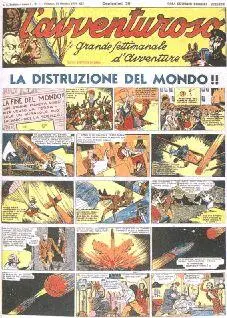
concocted by a certain Dr. Zarkov had landed on the planet Mongo, controlled by a cruel dictator, Ming the Merciless, whose name and features were diabolically Asiatic. Mongo: glass skyscrapers that rose from space platforms, underwater cities, kingdoms stretching through the trees of an immense forest, and characters ranging from the maned Lion Men to the Hawk Men and the Blue Magic Men of Queen Azura, all of them dressed with an easy syncretism, either in outfits that suggested a cinematic Middle Ages, like so many Robin Hoods, or in barbaric loricae and helmets, or occasionally (at court) in the uniforms of cuirassiers or uhlans or dragoons from turn-of-the-century operettas. And all of them, the good and the bad, were incongruously equipped not only with blades and arrows but also with prodigious ray guns, just as their conveyances ranged from scythed chariots to needle-nosed interplanetary rockets in colors as loud as Luna Park bumper cars.
Читать дальшеИнтервал:
Закладка:
Похожие книги на «The Mysterious Flame Of Queen Loana»
Представляем Вашему вниманию похожие книги на «The Mysterious Flame Of Queen Loana» списком для выбора. Мы отобрали схожую по названию и смыслу литературу в надежде предоставить читателям больше вариантов отыскать новые, интересные, ещё непрочитанные произведения.
Обсуждение, отзывы о книге «The Mysterious Flame Of Queen Loana» и просто собственные мнения читателей. Оставьте ваши комментарии, напишите, что Вы думаете о произведении, его смысле или главных героях. Укажите что конкретно понравилось, а что нет, и почему Вы так считаете.

